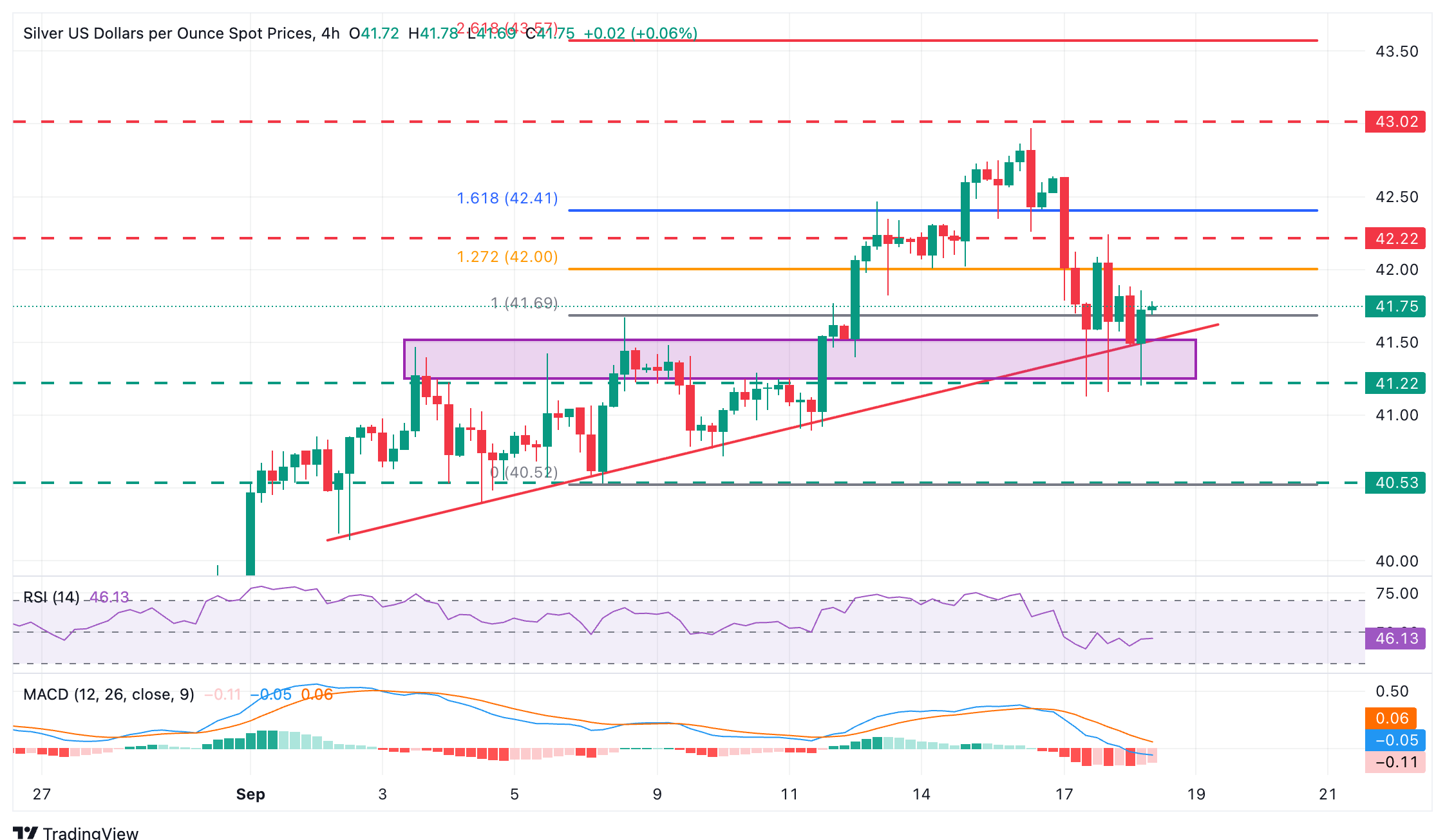Silver Price Forecast: XAG/USD bounces up to $41.80 as the Dollar loses steam
- Silver trims losses and returns to the upper range of the $41.00s, after bouncing from $41.10 lows
- The US Dollar recovery loses momentum amid a moderate risk appetite on Thursday.
- XAG/USD’s has a strong support area between $41.11 and $41.40.
Silver’s (XAG/USD) is paring previous losses on Thursday’s early European session. The precious metal has bounced at $41.20, returning to levels around $41.80 as the Dollar recovery loses steam amid a mild risk-on mood.
Precious metals pulled back from highs on Wednesday following a spike higher after the Federal Reserve confirmed a 25 bps rate cut and further monetary easing in the coming months.
The US central cut rates, as expected, and released a new “dot plot” anticipating 50 bps further cuts in 2025 and another quarter-point cut for next year. Somewhat later, Fed Chairman Powell curbed hopes of steep monetary easing, highlighting the challenges ahead stemming from the increasing price pressures, and provided a new impulse to the US Dollar.
Technical analysis: XAG/USD reversal contained above $41.10

The technical pìcture shows bearish pressure, with the Relative Strength Index and the MACD at negative levels, yet with the positive market sentiment adding weight to the USD recovery and support above $41.00 challenging Dollar bulls.
The pair, so far, remains above the trendline support from September 2 lows, now at 41.40, and the mentioned September 17 low, at $41.10. If these levels give way, the next targets are the $40.55 (September 8 low) and the $40.00 Psychological level.
To the upside, the intra-day resistance at $42.25 is the first significant hurdle for a potential bullish reaction. Further up, the targets are Wednesday’s high at the $43.00 area and the 261.8% retracement of the September 8 rally, at $43.55.
Silver FAQs
Silver is a precious metal highly traded among investors. It has been historically used as a store of value and a medium of exchange. Although less popular than Gold, traders may turn to Silver to diversify their investment portfolio, for its intrinsic value or as a potential hedge during high-inflation periods. Investors can buy physical Silver, in coins or in bars, or trade it through vehicles such as Exchange Traded Funds, which track its price on international markets.
Silver prices can move due to a wide range of factors. Geopolitical instability or fears of a deep recession can make Silver price escalate due to its safe-haven status, although to a lesser extent than Gold's. As a yieldless asset, Silver tends to rise with lower interest rates. Its moves also depend on how the US Dollar (USD) behaves as the asset is priced in dollars (XAG/USD). A strong Dollar tends to keep the price of Silver at bay, whereas a weaker Dollar is likely to propel prices up. Other factors such as investment demand, mining supply – Silver is much more abundant than Gold – and recycling rates can also affect prices.
Silver is widely used in industry, particularly in sectors such as electronics or solar energy, as it has one of the highest electric conductivity of all metals – more than Copper and Gold. A surge in demand can increase prices, while a decline tends to lower them. Dynamics in the US, Chinese and Indian economies can also contribute to price swings: for the US and particularly China, their big industrial sectors use Silver in various processes; in India, consumers’ demand for the precious metal for jewellery also plays a key role in setting prices.
Silver prices tend to follow Gold's moves. When Gold prices rise, Silver typically follows suit, as their status as safe-haven assets is similar. The Gold/Silver ratio, which shows the number of ounces of Silver needed to equal the value of one ounce of Gold, may help to determine the relative valuation between both metals. Some investors may consider a high ratio as an indicator that Silver is undervalued, or Gold is overvalued. On the contrary, a low ratio might suggest that Gold is undervalued relative to Silver.
